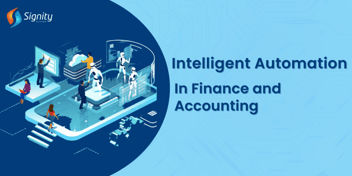Accounts Receivable Automation: Everything You Need to Know
Account receivable is a time-consuming process when done manually, but with AR automation, you can collect the right financial health metric at any given time. So, manage your account receivable with the right fit solution to improve the bottom line or customer relations.

In the past few years, the business landscape has become more competitive. And as a result, companies are increasingly favouring credit as a means of payment. While this certainly surges sales, it also brings red flags of delayed payments to businesses.
Don’t sleep over it! Account Receivable is here to be your cash flow superhero.
“Account Receivable (AR) is an accounting term related to money your customers owe you for goods or services purchased on credit”.
Though AR sounds simple and easy to ensure customers pay on time, it’s a chain of processes directly proportional to your company’s bottom line and customer relations.
Moreover, next-generation businesses have already started implementing accounts receivable automation with RPA to manifold the team’s productivity, minimize inefficiency, accelerate the payment process, and maintain a healthy cash flow with predictable payment cycles.
Herein, we’ll cover everything about accounts receivable - from why businesses should choose robotic process automation to automate accounts receivable to what are some of its benefits.
Key Takeaways:Accounts receivable automation can save businesses time and money by automating the manual tasks involved with invoicing customers and collecting payments. Studies show that companies that switch to automation also see an improvement in their days sales outstanding (DSO), which is the average number of days it takes a company to collect payment after a sale. This can improve cash flow and profitability. AR automation provides businesses with more accurate data, which can be used to improve customer outreach by automatically generating invoices, emailing payment reminders, and providing multiple payment options. |
So, let’s delve right into it -
What is Accounts Receivable Automation?
Account Receivable automation streamlines time-consuming and repetitive tasks in the manually carried AR process with software integrated to reduce costs, save time and improve efficiency.
An Accounts Receivable automation software accelerates the credit-to-cash cycle and streamlines the company’s financial transactions with its users. So, by optimizing every step in the AR process right from invoicing to reconciliation, the AR automation software improves the cash flow as well as working capital.
Why Everyone in the Business World is Automating Accounts Receivable?
Because the advantages of automating a conventionally operated account receivable process are unskippable. Let’s see!
#1. Streamlines the Workflow
It minimizes the time spent on processing the paperwork and payments. Plus, a more efficient workflow allows the AR team to focus on value-added strategic tasks.
#2. Quicker Invoicing
RPA allows automated workflows to pave the way to quicker invoicing while minimizing the company’s days of sales outstanding (DSO). Simply put, the result is faster payments and improved cash flow.
#3. Increased Data Accuracy
RPA bots help automate the accounts receivable process to eliminate the duplication of invoices and minimize billing disputes as the data extraction process is automated.
#Case Study: One-Stop Telecom achieves 100% accuracy in SkyFax services billing using RPA bots
Honestly, by reassuring the staff of the most repetitive tasks, small business automation software enables them to concentrate on predicting cash flows and managing overdue payments.
Before you inch ahead and start with account receivable automation, here are some frequently asked questions you should evaluate to maximize the value of your account receivable automation process.
Questions to Ask Before Automating Your Automation Process
Below are some pocketed questions that will help you evaluate the efficiency of your payment collection and credit activities and identify irregularities in the process.
How do you send invoices to customers?
Often, businesses and companies send invoices by email, as it’s the quickest way to get paid by the clients. But, in most of the scenarios, clients validate the information and then make the payment, consuming a lot of time.
Whereas, AR automation automatically generates invoices based on sales data, eliminating the need for manual data entry.
Case Study: How does Telecloud save 750+ man-hours per month in accounting with RPA
When do you want to send invoices to customers?
Usually, there are three options - Advance payment for SaaS-based products, a Hybrid approach of advance payments before starting the engagement, and month-end invoices. Or, choose to raise the invoices after a two-week cycle or at the end of the month.
What data inputs to collect for customers to generate invoices?
There is a long list of data that is inescapable to create invoices for clients. For example, an OCR-based account receivable software will capture data like invoice number, supplier name and address, project information, PO number, and many other crucial facts for tracking.
What are ideal payment terms, and what does it include?
Once you sign the agreement, the first and foremost step is to send the payment details followed by your organization. This includes:
- Invoice dates and due dates
- Currency
- Upfront costs (if any)
- Accepted payment methods
- Additional payment terms
How many types of billing configurations do companies offer?
There are mainly six types of billing configuration offered by organizations:
- Milestone Billing
- Progress Billing
- Sub-Line-Item Billing
- Billing on Completion
- Billing for Ongoing Services
- Prorated Billing
Regardless of the billing type, AR automation can help to streamline the process and improve the accuracy, efficiency, and effectiveness of your AR process.
Why do companies need order-to-cash automation?
Companies need to automate the order-to-cash process to optimize it for the most significant results. O2C automation for numerous services like procurement, credit control, risk management, and accounts receivable is a considerable strategy.
Furthermore, manual labour in non-automated or partially automated O2C processes can slow a company’s operation, resulting in delays and customer discontent. Also, in some scenarios non-automated O2C cycles might pave the way to more errors since individuals are more prone to make mistakes when putting data or switching between systems.
Will the software integrate with your ERP, and how?
This is the most important part when choosing software for your AR process. So, select an account receivable software that integrates with third-party software like ERM, CRM and accounting software. This approach will allow for a real-time flow of information that several teams can use.
Why should your software be PCI-DSS compliant?
PCI-DSS is the global security standard for all companies that store, manage, or send sensitive authentication and cardholder data. Also, PCI-DSS establishes a baseline degree of safety for customers and helps reduce any data breaches or potential threats throughout the payment ecosystem.
Why do you need safety protocols for user data?
Sometimes, both phrases are used interchangeably, and there is a huge difference between them. Data privacy is with whom you share the access, whereas data protection provides methods and rules to limit data access. Plus, compliance requirements ensure that organizations comply with customer privacy requests and are accountable for securing private user data.
Now, you are probably wondering what account receivable process can I automate. Shed the onus, here’s the answer!
We all have felt this way, sifting through a heap of paperwork to see how much is left to pay and reviewing any other notes taken on each customer between invoicing and payment.
This sentence was time-consuming enough to read; let’s straightway explore the AR process businesses as you can automate:
Customer Outreaching
Just think about software automatically generating and sending emails or messages to customers a week prior payment due date and, if required, sending another email two days after the payment due date.
All these types of communications can be set up and customized to each individual customer with a digital AR process.
Invoicing
Certainly, the core purpose of a successful accounts receivable process is receiving the funds owed towards the company, though the first step of which is invoicing clients.
With AR automation, invoices get generated automatically and can be delivered digitally in minimal time, probably in the blink of an eye. Even if VAT or sales tax applies, an automated system will identify the applicable tax rate for each transaction to make sure the correct amount is collected. AR automation can help in the B2B SaaS subscription billing process to manage the subscriber billing system.
Digital Payment Processing
Businesses often integrated a digital payment process to collect payments faster, therefore improving cash flow. Besides, it allows customers to establish auto-recurring payments, which acts as an added feather in the hat.
After all, the right implementation for a business could offer customers with a variety of payment choices. You can choose between automated clearing house (ACH) payments or use peer-to-peer payment apps. And, once a company receives payments, the system can send automated payment receipt notices to clients.
So, why wait? Let’s define the components of AR automation software.
Components of AR Automation Software
There’s no doubt, business managers want accounts receivable to be precise and efficient, while ensuring to be clear and make payments easy for customers. AR automation software has numerous key features to help businesses accomplish these goals.
A few are listed here:
Invoice Generation and Distribution
Producing and distributing invoices is the cornerstone of AR, and automation software can shed all the onus from your shoulder. Plus, timely invoicing can accelerate payment and improve the company’s cash flow.
Automated emails
This "set it and forget it" feature lets you automate your email reminders to clients. You can set up triggers to send emails to customers several days before a payment is due, and you can also set up triggers to send follow-up emails if a payment is late.
Multiple Points of Payments
AR software offers a myriad of payment options to customers, like check, ACH, credit cards, wire transfer, and peer-to-peer sharing platforms. This eventually makes it easier for customers to pay their invoices, which can lead to faster cash flow and improved customer satisfaction.
Transaction Matching
When a client makes a payment, it needs to be applied to the correct invoice. Automation tools can automatically match payments to invoices, which can help to reduce DSO and minimize the manual effort of cash application.
Dispute and Deduction
When a customer disputes a charge on an invoice, it is crucial to easily deduct the disputed charge and re-invoice the customer. This way you'll help to accelerate the resolution of the issue and shorten the wait time for the proper payment.
Data Reporting
Real-time intelligence and data analysis are put to use to detect payment trends, manage risk, and track DSO. Moreover, businesses are using this data to parse customer data based on a particular segment or category, or to monitor department productivity by analyzing the number of invoices created or collection calls completed by individual staff members.
Credit Risk and Management
When a business extends credit to customers, it takes on the risk that those customers may not pay their invoices on time or don't pay it all. Here, AR automation can help businesses identify customers who are most likely to default on their payments, which can help businesses to manage their risk and protect their bottom line.
So, What to Do Next?
The right automation tool is the one that caters to your business's unique needs. And the best way to start the product evaluation process is to ask for the input of employees who are presently performing the work. They know the accounting workflow in detail, so they can help you determine your organization's unique AR software requirements and identify any potential hiccups in the AR process.
We understand money earned is money collected. So, if you are sailing on the same ship and want to supercharge your cash flow, get started now!
Frequently Asked Questions
Have a question in mind? We are here to answer.
What does accounts receivable software do?
![]()
Accounts receivable (AR) software automates the process of managing customer payments. It can help businesses to lower costs, improve cash flow, and increase productivity. AR software can standardize invoices across a business's entire customer base, as well as handle communications on payment due dates and help reconcile the books.
What is the importance of accounts receivable management?
![]()
Accounts receivable (AR) is the process of managing customer payments for goods and services provided by a business. Effectively handling AR allows a company to track and collect payments in a timely manner, which helps to paint an accurate financial picture for the business. Automating the AR process can lead to faster collection of payments, which can improve cash flow and strengthen customer relationships.














